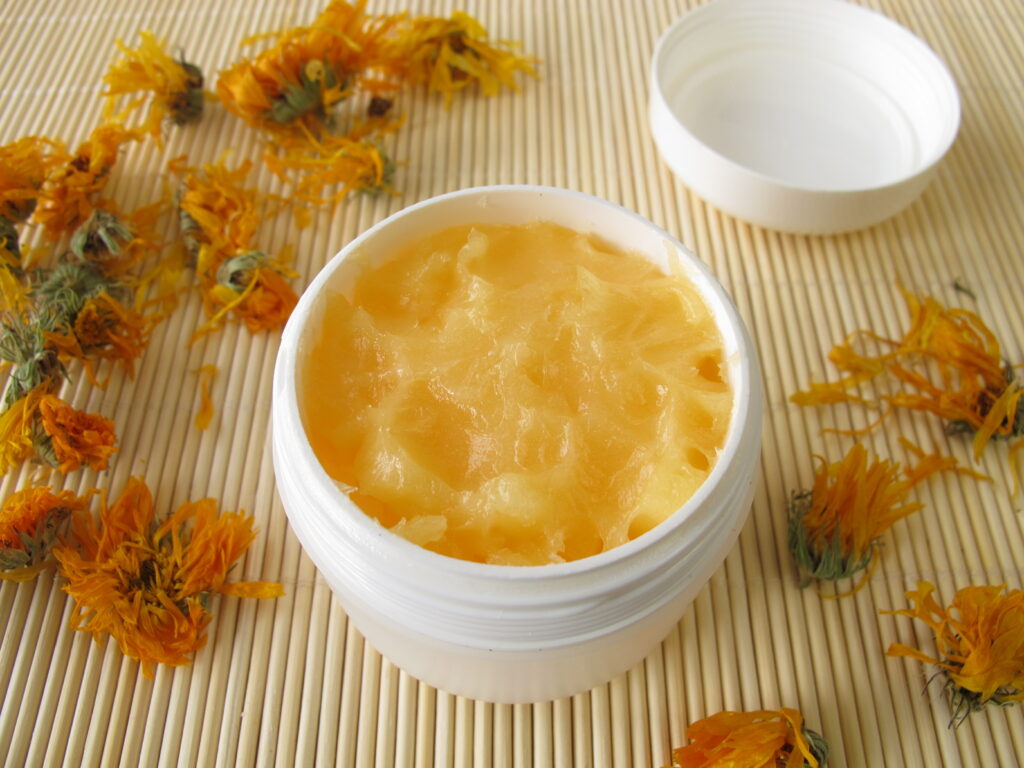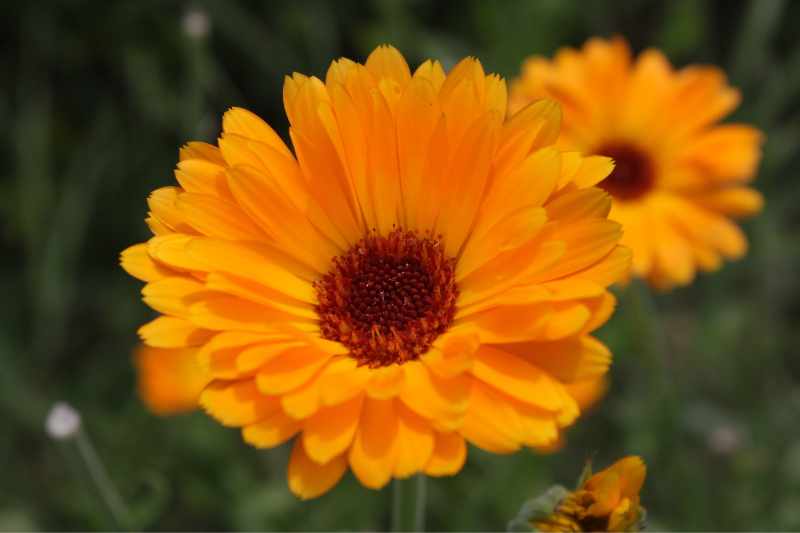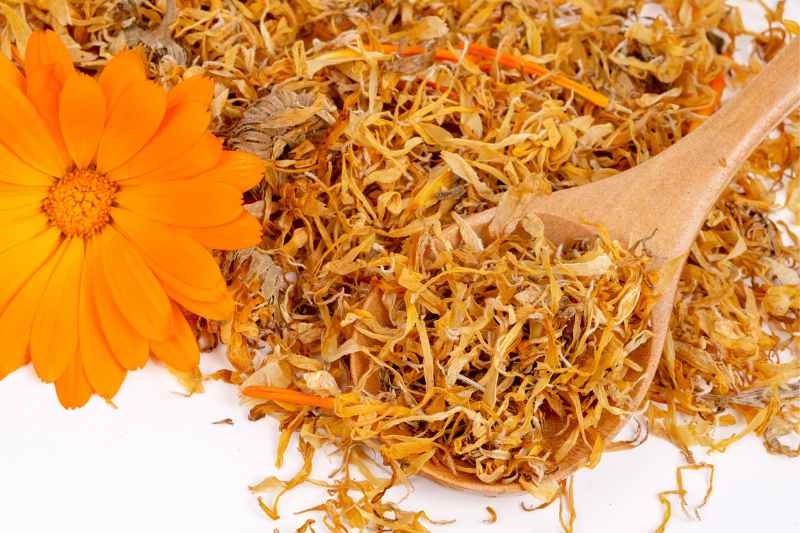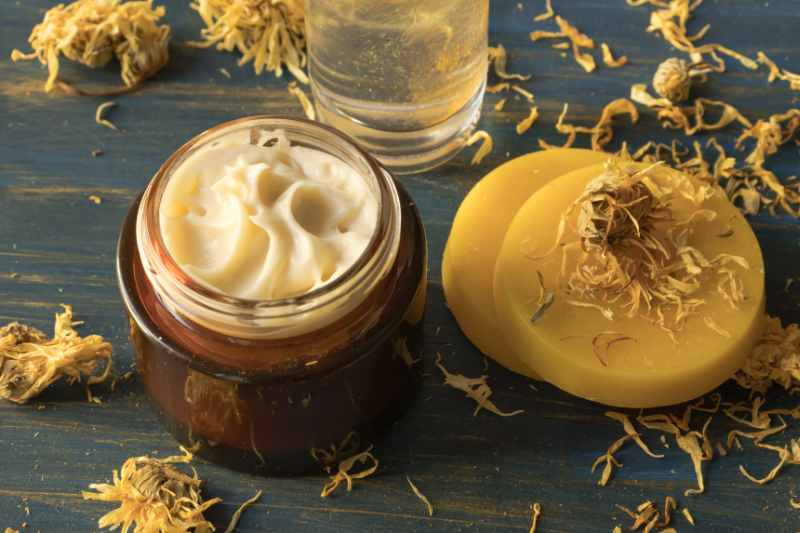Calendula or marigold is a pretty annual plant valued for its generous summer flowering in small daisy-like yellow-orange flowers that continue without interruption until the onset of winter. It is an edible flower that can be used in cooking in salads, herbal teas or infusions, but it is also a plant with many benefits. The flowers of Calendula officinalis or pot marigold have multiple medicinal and cosmetic virtues: soothing, astringent, anti-inflammatory and wound-healing. That is why calendula has been used for centuries to treat wounds, inflammation, burns and skin irritations. Calendula cream or ointment is a natural and effective remedy for all skin types. It is gentle, moisturising and protective. It can be used to soothe sensitive, irritated or dry skin and to repair chapped areas. Calendula cream soothes razor burn, calms baby redness, insect bites and sunburn. In this tutorial, we explain how to to grow calendula and make a homemade cream from its flowers!

Calendula, a marigold with no worries
Marigold is a frost‑tender perennial that cannot withstand frosts, which is why it is grown as an annual in our gardens. Very easy to grow, it is undemanding regarding soil and water. It grows in full sun in any well‑drained soil. Marigold forms a bushy, very floriferous clump, 20 to 70 cm tall for the tallest varieties. Calendula flowers from early summer and its abundant flowering continues without interruption until the first frosts, attracting pollinators, often until the onset of winter. With its radiant daisy-like flowers, sometimes double, lemon-yellow, grapefruit or bright orange, it brings cheer and lightness to natural and naturalistic gardens and country gardens, to cottage gardens where it is indispensable, but also in flower-filled vegetable gardens where it is very useful to pair it with other edible flowers and other melliferous plants. Calendula seeds are sown directly into open ground after frosts and up to June. They will self-seed in the garden if you let the flowers go to seed.

When to harvest calendula flowers?
Calendula flowers are harvested during flowering, from May–June to September–October depending on region and sowing date. Marigold flowers have the particularity of closing each evening at dusk, following the sun's path. For harvesting, use a clean pruning shear and cut stems when flowers are fully open. A proverb says « Picked at noon, when the sun is highest and warmest, marigold will strengthen and soothe the heart »!

How to make calendula moisturizing cream or marigold balm?
Step 1: Drying calendula petals
Keep only the petals, remove the centre. They should be dried as soon as they are harvested:
- Lay newspaper in a crate or on a work surface
- Spread petals making sure they do not touch
- Leave to dry in shade in a well‑ventilated place for about 3 days
- Once thoroughly dry, store them away from moisture and light in an airtight container

Step 2: Prepare an oil macerate
To enjoy calendula's external benefits, you must first macerate its petals in a vegetable oil to extract active compounds. For preparing the macerate you will need:
Ingredients:
- 1 large handful of dried marigold flowers = 20 g of flowers
- 100 ml vegetable oil such as extra virgin (first cold‑pressed) olive oil, sunflower oil, grapeseed oil, coconut oil, or very moisturising macadamia nut oil
Equipment:
- A sterilised glass jar such as a jam jar
- An elastic band
- A square of cloth
- A coffee filter or muslin
- A funnel
- An airtight glass bottle
Recipe:
- Fill the jar to four‑fifths with the dried flowers
- Completely cover the calendula flowers with vegetable oil
- Close the jar using the elastic band and the square of cloth (air must be able to circulate) and leave to infuse for at least 4 weeks in a warm sunny place, but protected from direct sunlight: for example place the jar in a kraft paper bag and put it near a sunny window.
- Stir the preparation daily to ensure an even infusion
- If the oil level drops, top up so the petals remain covered
- After infusion, strain the oil using a coffee filter or muslin to remove the flowers. Press well to recover the macerate. You will obtain a golden, fragrant oil rich in calendula's beneficial properties.
- Transfer the obtained oil into a previously sterilised airtight glass bottle
- This macerate can be used as is to treat dry or irritated skin. It is also useful for soothing sunburn or minor burns. It keeps for between 6 and 9 months away from light at room temperature.

Step 3: Making calendula cream
An emulsifying wax is necessary to obtain a smooth cream.
Ingredients:
- 6 tablespoons of dried calendula flower macerate
- 15 g beeswax
- 15 g shea butter
- 5 drops lavender essential oil (facultative) or chamomile, both calming and soothing
Equipment:
- A saucepan
- A second smaller saucepan or a container for bain‑marie
- A small sterilised glass pot
Preparation of the multifunction calendula cream:
- In the saucepan, with a wooden spoon, mix the macerate with beeswax and shea butter
- Heat the mixture gently in a bain‑marie until beeswax and shea butter are melted
- Let cool then, add (if you wish) the essential oil
- Pour the mixture into a small sterilised airtight glass jar
- This cream keeps for 6 months in the fridge
- To make a calendula balm, use of shea butter is not necessary, as a balm has a firmer consistency than a cream.

How to use homemade calendula cream?
Homemade calendula cream is perfect for hydrating and soothing skin. It can be used on hands, face and areas prone to drying or needing care. Thanks to its anti-inflammatory and wound-healing properties, it is also excellent for treating small cuts and grazes.































Comments